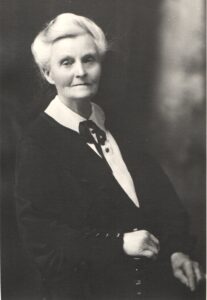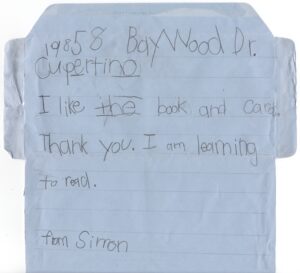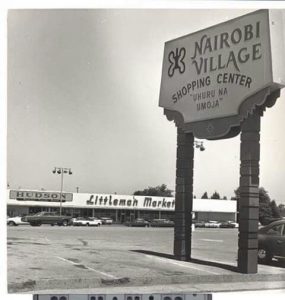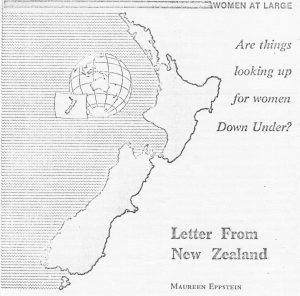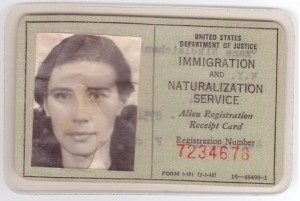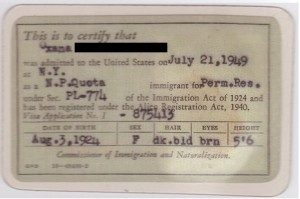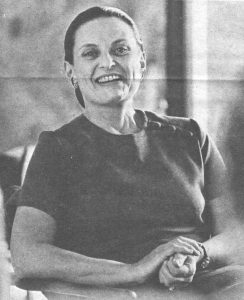Sharing the joy of language
 In my old black filing cabinet I find a treasure: a few stapled sheets of pink copy paper printed with the unmistakable purple ink of a ditto machine. It is the output of my first poetry teaching gig. I explain in a letter to my parents.
In my old black filing cabinet I find a treasure: a few stapled sheets of pink copy paper printed with the unmistakable purple ink of a ditto machine. It is the output of my first poetry teaching gig. I explain in a letter to my parents.
March 1, 1971
I am starting on Friday teaching one hour a week at [my son’s] school. This is what they call a scramble program, where 1st, 2nd and 3rd graders (6-9 yr-olds) are all mixed together to take activities of their own choice, from a list that includes ceramics, folk-dancing, tennis, guitar playing, cookery, woodwork, arts & crafts, etc. The teachers and mothers involved get to teach whatever they are interested in. I am taking a group who are interested in writing poetry. It should be fun, but requires a lot of preparation.
 As a university student in New Zealand I had chosen not to make teaching my profession. I’ve not regretted this decision. But over the years I have enjoyed the challenge of teaching short-term writing programs, though even this first one had its moments.
As a university student in New Zealand I had chosen not to make teaching my profession. I’ve not regretted this decision. But over the years I have enjoyed the challenge of teaching short-term writing programs, though even this first one had its moments.
March 29, 1971
My poetry class is coming along quite well, though conditions were a bit poor last week – it was raining, & all the frustrated outdoor games kids crowded into the library too, & my poor kids couldn’t get into the mood.
At the end of the program I would have made enough copies of the pink sheets for all the children in my group to take home. I still remember the frustration of making ditto masters, using a manual typewriter with the ribbon removed. Any mistake and you had to start over. I still remember the smell of the alcohol solvent that permeated the printed pages. I also remember the children’s joy in the power of language.
Today I’d like to give a shout-out to California Poets in the Schools, a program that not only places poet-teachers in classrooms, but also provides training and resources to help them in their work of “empower[ing] students of all ages throughout California to express their creativity, imagination, and intellectual curiosity through writing, performing and publishing their own poetry.” And I’m in awe of the technologies that support a quality of publication way beyond my pathetic purple dittoes.
A legacy of crocheted lace
A comment in an old letter to my mother catches my eye:
March 1, 1971
I can’t remember anything about that bit of crochet, Mum, but I guess it probably is mine. Now it will sit in my workbox for years!
Do I still have it? I open the Cadbury’s Chocolate box that holds my collection of crochet hooks and sundry balls of crochet thread. On top sits a small piece of lace, obviously the beginnings of an ambitious project. Was it the piece that cluttered Mum’s workbox? Probably.
The art of crochet was honored in my mother’s family, passed on, like all domestic arts, from generation to generation. The most noted expert was my great-grandmother, Sarah Jane Caundle, whom I met a few times when I was a child. She was born in 1864 to Irish immigrants on a New Zealand goldfield. In a reminiscence my mother wrote:
Outside the back door [of Grandma’s house] in the sun was a stool to sit on. Across the yard in a shed that housed the wash house with its copper and wooden tubs with the toilet next to it. Grandma washed the clothes in the old way with a well-stoked fire under the copper to boil the sheets, etc. The tubs for the rinsing and blueing with a hand-turned wringer between them. While visiting as a small girl I was being taught how to crochet. Trying to make my doll a pink woolen petticoat like the ones Grandma made for us. Something would not go right so I called for assistance. There was Grandma coming across the yard at her usual jog-trot wiping the soapsuds off her arms on her apron (Must always wear an apron) to sort out my muddle. The picture is still so clear in my mind.
… As we grew older we were given doilies and crochet-edged linen for our “box.” At each 21st birthday each granddaughter was presented with an afternoon tea cloth with a wide edge of crochet lace.
Before she died in 1951, Great-Grandma Caundle had started making doilies for her great-granddaughters. I missed out, but inherited a piece of her work from my mother. Fascinated by Mum’s stories about her grandmother’s life, I put together a poem:
Great-Grandma’s Doily
Early afternoon, when chores were done,
Great-Grandma put her feet up on the kitchen couch
and gave herself an hour with crochet hook and thread
to figure out the sequence from a photograph—
chain and double loop and treble—
the mathematical progression of the rounds
revealing patterns satisfying in their laciness.
She learned the art at her mother’s knee
in the dirt-floored hut at the Puriri claim.
Her mother learned it from her Mam
back in Ireland before famine memories
and rumors of gold in the far-off colonies
took Bernie Donnelly and his new young wife
adventuring across the world.
There was a dame school at the diggings.
Great-Grandma might have gone some days
but not enough for fluency in letters.
She had sisters and brothers to mind,
manuka-twig brooms to fashion for the floor,
clay to fetch for the hearth’s weekly whitewash of mud.
She entered service as a housemaid at eleven.
Later came marriage and children of her own,
nine of them, then grandchildren to care for.
All this time persisting in her art,
gifting to daughters and grand-daughters
lacy linens for their marriage chests.
I have one doily, handed down, an oval of white linen
edged with a crocheted frill of tulips in a row,
each stitch pulled neat and tight, a testament
to discipline and practice, and the will
to make time for her art.
A spat in slow motion
A spat between parent and adult child is different when conducted on flimsy blue international air letter forms. For one thing, it happens in slow motion: weeks pass between riposte and retort. For another, it’s solitary: neither side can see the angry tears of the other. And it’s documented; that is, if letters are kept. My mother kept all mine, and gave the bundle back to me. I constantly regret that I didn’t keep hers, so have to guess at the comment to which a letter of hers or mine would have responded.
A typical example happened in late 1971. Decades later, as I read through my old words, I recognize patterns of individuation familiar to every psychoanalyst.
It started with a postscript to a birthday thank-you note my six-year-old son had written on Nov. 13, 1971.
At the bottom of the page I’d scrawled:
Do I assume that you have given up writing to me?
Mum’s response, as I remember it, was to the effect that if she wrote to one member of my family, it was to be assumed that she was thinking of us all. Here’s my response:
Nov. 23, 1971
I’m sorry that you got so uptight about my comment, Mum. However, I think we should clear up some basic misunderstandings about the children. I am delighted that you have written to them, and they are too. They think it is pretty special when an adult relative takes an interest in them. But it is very important to me that the kids be seen as individual people, with interests and responsibilities of their own, and this includes developing communications with other adults outside the immediate family. This, I think, is a reaction to my own childhood, when you tended to take over any attempts we made to establish relationships with other people. Now don’t get upset – I’m just trying to show you how I see myself, and how I see my kids. If you only have time to write to the kids, that’s O.K. I’ll encourage them to answer your letters, but there may be some long gaps. They are not big enough yet to handle a regular correspondence. But I have no intention of taking over the responsibility for them, nor of regarding your letters to them as some sort of gimmick substitute. I am an individual person too, and I haven’t had a letter from you since August.
We made up our differences in the next round of letters. In response to her plaint about the difficulty of being a parent, I wrote:
Dec. 14, 1971
I know what you mean, Mum, about bringing up kids. I sometimes wonder what these two will hold against me when they grow up, and it’s sure to be something I’ve never thought of.
Saga of an unpublished novel
In the bottom drawer of my old black filing cabinet sits a beat-up cardboard box that contains the dog-eared manuscript of my first completed novel in the US, “A Stone from the Wall.” The saga of my attempts to get it published, as reflected in letters to my parents, may get a nod of recognition from other aspiring writers.
March 15, 1972
I have finally got my book off my hands. I received an invitation last week to submit it to Houghton Mifflin Co., one of the most prestigious of the major publishing companies, so after a final frantic effort to finish typing the fair copy, it is now on its way. Whether they will buy it or not is of course another matter, but just to get an editor there enthusiastic about the idea is a tremendous boost. It is their sort of book—a serious look at a contemporary theme. My subject is racial prejudice, and the point I am trying to make is that, for a white person trying to come to terms with racial problems, the most difficult, and even painful, part is learning to recognize your own prejudices. This is mainly, of course, because the more concerned you become, the more you want to think of yourself as one of the good guys.
July 2, 1972
I was going to leave finishing this until after the mailman came today, but don’t really see the point. If I seem a bit edgy in this letter, I am. I was told by Random House that I would hear from them within 4-6 weeks. It is now nearly 5 weeks, and my heart starts hurting every time the mail truck goes up the road. It’s very tedious bracing yourself for rejection every day.
At some point I received a hand-written rejection note from the editor-in-chief of an eminent house—I believe it was Robert Gottlieb of Alfred A. Knopf—who complimented me on my “ability to make my characters come alive,” which buoyed me up for a few more rounds of submission and rejection. I no longer have the note or, for that matter, any of the many rejection notices I received.
July 25, 1972
My book showed up on the doorstep again, as expected. Disappointing of course, but this time I have decided to revise a lot of it before sending it out again. When you are writing fiction, you become in a very real sense the characters you are writing about, and sometimes it is difficult to stand back and look at them objectively—like it is difficult to look at yourself. But now I think I can see at least some areas where the characters are not interesting, or even not alive, but just vehicles for ideas. However, I am going to leave it now until fall—it’s just too difficult to work over the summer. The kids are very good, but they are something of a distraction. In the meantime I have various other articles and poems doing the rounds. They come back periodically, of course, but I figure that with enough things going, I’ll get somewhere eventually. I have had a couple of commissions from Tui [my editor at the Christchurch Press] which I have now sent off … I do still get very depressed every so often, but Tony usually manages to pull me out of it if I can’t shake it off myself. I even made a list this week of all the other things I was going to accomplish this summer. Boring jobs like cleaning the oven figure rather prominently …
November 1972
I am trying to get back to my novel, but keep getting sidetracked with new ideas [for stories and articles]. Have just finished grading a big set of students’ short stories for Millicent [the high school teacher for whom I worked]. Tremendous ideas and effort, but my main reaction as I tore each one apart was, my gosh, that’s what’s wrong with my writing too.
Discouraged, and preoccupied with other projects, I eventually gave up and moved on. As I noted in my blog essay “The Other Side of the Freeway,” I understand now why “A Stone from the Wall” never found a publisher. I was way too new to this country, and way too naïve, to do justice to its thorny subject. I didn’t understand how much the life experiences, interests, and even musical tastes of my African-American characters might be different from those of my white characters. Though I devoured my subscription to The Writer magazine from cover to cover, the protocols of book publishing still felt like an enormous black hole. The battered manuscript box deservedly stays in the bottom drawer of my old black filing cabinet.
Technological breakthrough brings excitement
On March 29, 1971 I scrawled a letter to my parents on the back of a copied newspaper clipping. In it I wrote:
We thought you might be interested in this cutting from the New York Times. It was also reproduced in the local paper, as well as the major papers in Chicago, San Francisco and Los Angeles, and the phone hasn’t stopped ringing at CMX [the company where my husband Tony worked] ever since. They have been demonstrating to all the major movie & TV producers & advertising agencies – a fascinating assortment of characters around the place, Tony says. Tony is going to Denver, Colorado for a magnetics conference the week after Easter. I think he is feeling quite amused about confronting the magnetics “Establishment” who were convinced that what he did (using magnetic computer disks to record video pictures) was technically impossible.
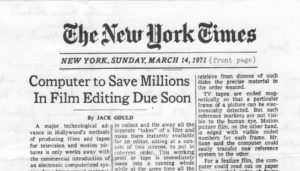 The article, by Jack Gould, the New York Times’s television and radio critic and reporter, goes into more detail. “Computer to Save Millions in Film Editing Due Soon” is its title. Calling it “a major technological advance in Hollywood’s methods of producing films and tapes for television and motion pictures,” he wrote:
The article, by Jack Gould, the New York Times’s television and radio critic and reporter, goes into more detail. “Computer to Save Millions in Film Editing Due Soon” is its title. Calling it “a major technological advance in Hollywood’s methods of producing films and tapes for television and motion pictures,” he wrote:
“In layman’s terms, the heart of the CMX system is its ability to collect and file away all the separate “takes” of a film and make them instantly available for an editor, sitting at a console of two screens, to put in coherent order. This working print or tape is immediately made into a running whole while at the same time all the trims and cuts are preserved for later consideration.
“Operation of the system borders on the eerie. The console operator can order up whatever he wishes to see. He presses no buttons or pulls any switches. Rather, he uses a pencil light that directs the system to offer a choice of “menus,” i.e., whether he wants the system to record, play back or edit.
“If the director wants to see Scene 1 of Act 2, he presses his pencil light, actually a photoelectric cell, against those words on the face of the screen. Instantly there is a still picture denoting that the sequence is ready for study. The light is then pressed against the word “run” and the scene starts.
“With the same pencil light the operator can order the system to stop. He can thereupon order a new starting point and new ending. Thereafter he can review the edited scenes and, if he wishes, compare them with the original.”
CMX Systems was a joint venture between the Columbia Broadcasting System television network and Memorex Corp., the company that had brought us to California in 1967. According to Wikipedia, the company’s name stood for CBS, Memorex, and eXperimental. Tony and his colleagues shared a patent for their work, as well as the satisfaction of having contributed to a breakthrough in technology. The company was sold in 1974, and Tony returned to Memorex, where he continued to work on magnetic recording technologies.
Community battles housing discrimination
In the early 1970s, my husband and I volunteered with Mid-Peninsula Citizens for Fair Housing. Here’s an article about the organization I wrote for my Christchurch, New Zealand paper.
FAIR HOUSING: A COMMUNITY APPROACH
Cupertino, CA, 1972
Discrimination in housing on the basis of race, color, religion or national origin has been illegal in the United States since 1968. But it is not so easy to legislate away prejudices so deeply ingrained that they are written into the textbooks of realtors and enshrined in the housing patterns of all our communities.
One group that has found this out the hard way is a San Francisco Peninsula organization called Mid-Peninsula Citizens for Fair Housing. Committed to the right of all persons to purchase or rent property wherever they choose, MCFH evolved in 1965 out of a nucleus of citizens who had fought an election proposition that would write in to the California constitution the right of the housing industry to perpetuate the existing discriminatory housing patterns.
The proposition passed, and MCFH learned its first lesson, that even in this allegedly liberal area, the housing market was tight shut.
Education, they concluded, was the key. By the time the federal Civil Rights Act of 1968 outlawed all measures like Proposition 14, MCFH had speakers visiting schools, factories and church meetings. Representatives started talking with local government officials and housing developers, focusing attention on the problems of housing for the aged, and other low income groups, as well as on racial minorities. A full-time lobbyist was employed to keep in touch with elected representatives in Sacramento, the state capital.
With the legal clout of the 1968 Act, they set up a legal aid service for members of minority groups discriminated against in obtaining housing. When a complaint is received, the Fair Housing Office sends out a White volunteer checker. In order to eliminate other legitimate grounds for a landlord to refuse an apartment, the checker matches the complainant as closely as possible, in everything except race.
The availability of the home, and the terms offered, are compared. If discrimination is apparent, MCFH offers the services of a volunteer lawyer, or assistance in filing a complaint with HUD.
But still this was not enough. Blacks and Chicanos, seeing the organization as yet another example of white liberal condescension, have been reluctant to contact the Fair Housing Office. On current showing it is affecting only one percent of the apartments in the area each year, and even fewer of the real estate sales. Meanwhile Peninsula communities are becoming more and more segregated, in terms of race, age, and economic status.
Now MCFH has added a new weapon to its arsenal. It is the community audit, a technique designed by Howard Lewis, a local realtor and vice-president of MCFH. The method used for an audit is much the same as that used to check individual complaints. The difference is that it is done by people already living in the neighborhood, who see their effort as a contribution to the community as a whole, and not to their individual housing needs.
Teams of checkers are made up: one White, one of a minority race. Most of the audits so far have been White/Black, but some White/Chicano audits are getting under way. One after the other the team members apply to their assigned apartments, and report back on the terms offered to them. The results are frequently double-checked, cautious MCFH lawyers preferring to give apartment managers the benefit of the doubt in dubious cases. But eventually a profile of the city’s housing practices emerges: in so many cases the Black was told that nothing was available, but the White was invited right in; in so many cases the rent quoted to the Black was higher, or the cleaning deposit was larger, or the credit check would take longer. The figures run between fifty percent and sixty percent for most of the varieties of discrimination, and the overall figure has been as high as seventy percent of the apartment units in any one city.
Reports are made to the individual apartment managers and owners, complimenting those who were shown to be obeying the law, seeking consultation with those who don’t. “The very least a fair housing organization can do,” says Fair Housing Director Marilyn Nyborg, “is contact housing industry members and talk with them—to deal with their fears, inform them of the law, and seek their commitment to equal opportunity in housing.”
The audits are repeated quarterly, and MCFH is prepared to take legal action against persistent offenders. But its members feel that local pressure is a more satisfactory incentive for obeying the law. For this reason the city council and the local press are also informed of the results of the survey.
Some city councils have reacted with suspicion and hostility; others have been spurred to initiate positive programs for their city’s housing needs. The City of Palo Alto, for instance, has set up meetings between discriminating apartment owners, representatives of MCFH, and its own Human Relations Commission; has agreed to act as co-plaintiff in discrimination cases; and has given notice, through a mailing to its utilities customers, that fair housing laws will be enforced in the city. Under discussion are ordinances that would provide for a public vacancy list; for the licensing of apartment managers; and for the use of written records of the terms offered to every prospective tenant. These stricter regulations are necessary, MCFH claims, because the education sessions they already provide for apartment managers have had little effect on their attitudes or practices.
We can influence the quality of life in our own communities, says MCFH. And change, though painfully slow, is happening. A few housing developers have publicly committed themselves to equal opportunity in housing. Some local realtors now display fair housing pledges in their windows. Membership of MCFH has swelled from the original handful of people to well over 2,000, and the annual operating budget, including contributions from local industries, is over $17,000. The organization is still a long way from its ultimate goal, equal justice for all in the housing market. But it is on its way.
The other side of the freeway
In the bottom drawer of my old black filing cabinet sits a battered cardboard box containing the manuscript of a novel I wrote in the early 1970s. I understand now why it never found a publisher. I was way too new to this country, and way too naïve, to do justice to its thorny subject: racial discrimination in housing. As I reread some of the text, I recalled the shock I felt when I first grasped the magnitude of the social gaps. The descriptions that follow come from my own experience as I researched the book, and it began my involvement with the fair housing movement.
Here is the central character Karen, a newspaper reporter, visiting the black ghetto of East Palo Alto for the first time to interview the director of a community advice center:
She knew vaguely that East Palo Alto belonged to the county. … She crossed the county line now, and accelerated to get onto the overpass that spanned the freeway. As she came down the ramp on the other side, she knew she was in a different country. The road was suddenly pot-holed and bumpy, and brown dust rose in thick choking swirls from its verges. She slowed, and looked about her. Such tiny bedraggled houses, desperately in need of paint. Yards littered with junk, yet here and there a brave attempt at order and color, a flower-bed, a well-cut lawn. She came upon a few tatty shops. Surely this couldn’t be the main shopping center? Yet soon she could see the sign, NAIROBI SHOPPING CENTER, and underneath, in a language she could not understand, UHURU NA UMOJA.
She had to force herself to open the door. Lurid accounts of rapes and muggings and violence in the streets flooded her mind. Here she was the enemy. She wanted to jump back into the car and get out, away from this place.
A woman passed, with two small children, headed for the market. She looked indifferently at Karen as she passed, then turned to scold one of the children, who was whining for candy. Karen let out the breath she had been involuntarily holding, and made herself move on. … Across the road, outside a liquor store, a black knot of middle-aged men stood transfixed in time, waiting for nothing.
It was hot. The dust lifted lazily as she walked. Something about the huge trees, and the stillness of the air, brought to her mind descriptions she had read of towns in the southern states. But this was California. It did not make sense. A mockingbird flashed its wings across her path, still proudly singing.
Karen does her interview, in which she learns about the pressures of living in East Palo Alto (and also finds herself attracted to Paul, the advice center director).
She said goodbye, and walked slowly back to the car, past the Louisiana Soul Food Kitchen and the Black and Tan Barber. The heat and dust were almost unbearable.
Back across the freeway, she noticed for the first time the neatly swinging redwood sign: Welcome to Palo Alto. A few blocks further down University Avenue and it hit her like a punch in the gut. She pulled over to the side of the road and rested her head on the steering wheel, fighting back an impulse to vomit. The contrast was an obscenity. Huge magnolias here lined the street on both sides, giving deep dappled shade to the well-paved highway. Between the road and the white concrete sidewalks rose great greening mounds of juniper and ivy, and beyond them, with manicured lawns and discreet sprinkler systems, were the complacent mansions of the rich.
Rumblings in the socialist paradise
I sold this early 1970s article about feminism in New Zealand to a US magazine. Unfortunately, the journal folded just after I’d received the galley proofs. Disappointing, but hey, these things happen. Reading the galleys again, I recognize many of my own frustrations, and understand a little better why I had to leave. I realize, of course, that New Zealand society today is very different from what it was then.
Letter From New Zealand
In New Zealand we say it is the land that shapes the people.
The land is lovely, but aloof; it has not welcomed intruders. For a few square miles the forest and scrub have given way, but the houses sit impermanent as boxes on the clearings, and in the towns the raw suburbs perch in self-conscious rows.
Europeans have been here for scarcely a hundred years. From the industrial ferment of 19th century Britain they brought a legacy of radical socialism, and from the obduracy of the land they grew a people that glorified the strong men, the rough, the plain-spoken, and left to its women the care of the arts and the domestic hearth. Together these two strands wove a welfare state that, in providing an economic floor beneath which no family can fall, has codified the disparities between the sexes, and underlined the definition of woman as housewife.
In the 1930s and ‘40s the pattern of social experiment these pioneers began reached its flowering in a social security system that offered a minimum wage, compulsory arbitration of wage disputes, pensions for invalids and deserted wives, family allowances that can be capitalized into housing down payments, low interest housing loans, low rent state houses, and a national health service that provides free medicines and medical treatment. A school dental service provides free dental care for all children. Most recently, in April 1974, an accident compensation scheme went into effect that covers everyone on New Zealand soil, whether earning money or not.
It is a complacently comfortable floor. But at its foundation is the assumption that the only proper place for a woman is in the home taking care of the children.
The welfare of the child is the prevailing argument. Says Norman King, New Zealand Minister of Social Welfare: “The majority feel that a close relationship with its own mother is the birthright of the New Zealand child. We do not want to encourage the adoption of a lifestyle in New Zealand where it becomes normal for the care of very young children to be a specialist task carried out by trained staff in group situations away from the family.”
New Zealand women achieved the right to vote in 1893, second only to Wyoming. Otago University in N.Z. admitted women to degree courses in 1871, the first in the British Empire. There are today very few women Members of Parliament, and no women at all in the administrative levels of higher education. Those who have reached positions of authority in any field are regarded as exceptions to the norm. And in a country as small as New Zealand, to be different is to be disapproved. A friend who returned home after ten years in London says: “Everything in New Zealand presses on me to settle down, to conform, to live safely, not to take risks.” My elder sister, Evelyn Stokes, has a doctorate in geography from an American university. Hostile vibrations still echo in our family over her decision to place her two children in a day care nursery so she could continue her university teaching.
Official thinking assumes that a mother who goes out to work does so either from economic necessity or from disproportionate greed. The idea that women might have talents other than domestic comes hard to New Zealanders. It is certainly not fostered by our education system, which from the start locks children into rigid sex role definitions.
From six-year-old Donald, Evelyn Stokes’s son, comes a crumpled school paper.
Check what toys girls like, he is instructed.
Big and little dolls? Yes, marks Donald. Correct, marks the teacher.
A train? No, marks Donald. Correct, marks the teacher.
A football? No, marks Donald. Correct, marks the teacher.
At the high school level the curriculum encourages vocational discrimination by sex: academic girls are steered towards the arts rather than the sciences, and average girls towards secretarial or home-craft courses.
But the winds of rebellion, fanned by global news services and travelers’ tales, are stirring the curtains at the kitchen windows. Women are staying at school longer and leaving with higher educational qualifications than ten years ago. The percentages of women and of married women in the work force are still lower than most western countries. But their numbers are increasing steadily, despite recent changes in the family benefit structure aimed at dissuading mothers from going out to work. Equal pay recently became law, and will be at least nominally applicable to all areas of the workforce by 1978.
Social custom compounds the problems of those married women who do go out to work.
Pat Brown has her own advertising agency. She told me that a company party with her husband, chief chemist at a freezing works, she attempted to discuss with his colleagues the implications of advertising and the sale of meat. Her husband’s boss took her firmly by the hand and led her to the far side of the room, where the other wives were discussing babies and knitting patterns. “This is your place,” he said.
Domestic duties are another stumbling block. Marriage counselor Marianne Thorpe says: “The difficulty is that women feel that they are responsible for the care of the home and children (and they get almost no help in this task), and this makes working outside the home a complicated business.” Evelyn Stokes and her husband Brian, head of math at a teachers’ college, share responsibility for housework and child care. It is an unusual set-up for a New Zealand family. More typical is Ray Lealand, now retired after a double career of clerical work and home-making, who says: “The most difficult problem I faced whilst working was non-cooperation from my husband.”
Role demarcation in some families is incredibly rigid. One friend recalls the raised eyebrows in her family when as a young bride she took on the vegetable garden. “That’s the husband’s job,” she was told. “The wife does the flowers.”
Since most women expect to stay home once they have a child, the idea of maternity leave is not widely accepted. When Evelyn Stokes applied for leave for the birth of her second child, the committee set up to look into the matter came back with a regulation that a mother who applies for maternity leave “is required to satisfy the university that her additional family duties are compatible with the continuation of her employment.”
Child care facilities for working mothers are inadequate, and though support for day care centers was a major plank in the ruling Labour Party’s 1972 election platform, its implementation has been whittled down to a subsidy to needy children in existing voluntary centers. Part-time employment coinciding with school hours is widely accepted, but employers will take on mothers of preschoolers only as a last resort, and use the argument of family responsibilities to pin women to the lower scale, “temporary” job classifications.
Sex role definitions still apply in employment. Six occupation groups employ 65% of New Zealand’s working women: clerical, sales, clothing manufacture, teaching, nursing, and domestic service. But there has been some movement into the traditionally male areas of drafting, electronics, and electrical work, and into the newer technological jobs like computer programming or systems analysis, where sex-exclusive traditions have not yet calcified. With a shortage of male labor in many fields, a few pioneers are braving the public ridicule and breaking down job opportunity barriers. One such incident, in 1972, even rated media coverage. Two girls applied for jobs in an Auckland factory as aluminum glaziers, only to be told this was not a woman’s job. When they asked “Why not?’ no answer could be found, and they were taken on.
This thread of social change is closely woven with another that is a constant in New Zealand life. Few in numbers, and isolated by thousands of miles from the sources of our culture, we have been almost pathologically dependent on the word from the outside world. I remember my first beat as a cub reporter; I scurried round the tourist hotels of Christchurch, winkling out startled visitors and begging them to express an opinion. Any opinion. Still the pattern continues. Articulate voices from abroad, no matter what their status, receive far more attention than local expects on the same subject.
The feminist movement is a case in point. Local groups springing up in the past few years have found a climate of hostility and ridicule. The ideas of American feminists, distorted by distance and by different cultural norms, have seemed to many to be irrelevant to the New Zealand experience. Then early in 1973 two visitors coincided: Evelyn Reed, an American Marxist feminist who advocated abortion law reform and improved child care facilities, and Dr. John Bowlby, a British psychiatrist know for his work on the deleterious effects of maternal deprivation on a child’s mental health. Both, basking in the aura of the magic words “from overseas,” were taken seriously by the local press. Margot Roth, editor of the Journal of the N.Z. Society for Research on Women, comments that the resulting controversy opened up a much wider range than usual of questions concerning women, and helped lay the foundation for the success of a United Women’s Convention held September 1973 in Auckland to mark the 80th anniversary of women’s suffrage.
The purpose of the convention, according to the organizers, was to correct the distorted view New Zealand women had of modern feminism, to raise the status and self-confidence of women, and to increase the numbers of women willing to work on behalf of women’s issues.
Statistics indicate that the fifteen hundred women who attended, while better educated and more likely to be employed than the average, nevertheless made up a remarkably accurate cross-section of New Zealand society. The issues discussed were those that concern women everywhere: job opportunities, control of their bodies, marriage and child care, sex stereotyping.
Press reportage of the Convention again sought to trivialize and ridicule. Afternoon TV revealed to local mums some of the hogwash poured down the verbal ducts at the United Women’s Convention, reported one city daily.
However, rage over press flippancy reinforced a feeling of unity at the conference, and the consensus of those who attended is that, for the first time, women from the whole range of backgrounds and interests in New Zealand life experienced a feeling of sisterhood.
The floodgates are open. Women with common interests are pooling resources. The prestigious National Council of Women, umbrella for all women’s organizations in New Zealand, and for long a stronghold of the traditional view, is now espousing the cause of equality and encouraging its affiliated groups to contribute.
It is hard to say what the future will hold. Though New Zealanders travel the world as casually as migrating godwits, jet planes cannot eliminate the sense of lonely isolation that makes us belittle our homegrown prophets. The land still broods, raw, stubborn, and the people it has bred still revere the sheep shearer above the artist. On embroidered tablecloths, housewives still set teas of cream cakes and scones, and rows of preserves still gleam on pantry shelves.
But the women of New Zealand have a stubborn streak too. Diffident, shy, self-conscious in proclaiming the ideas that come from an almost alien American culture, we are nevertheless gathering strength. The spirit that made New Zealand one of the most comfortable societies in the world may yet take a mattock to the scrublands of tradition, and graze the new fields of equality.
The citizenship decision
In 1972, five years after I emigrated to the US clutching my hard-won Green Card, my official status was Resident Alien. I was required to register at the Post Office every January. If I wanted to leave the country, I had to prove that my income tax payments were up to date. I had to remain “of good moral character” and could be expelled if I had a run-in with the law. And I couldn’t vote.
Meanwhile, opposition to US involvement in Viet Nam was heating up. A turning point for me was the May 1970 killing and wounding of students by members of the National Guard at Kent State University, where students were protesting the secret bombing of Cambodia. As a history major, I already understood why interference in another country’s self-determination was bound to end badly. It was obvious to me as an outsider that the Viet Nam War was a disaster. Yet here in this supposed Land of the Free, it seemed that the authorities were beating up people who said so.
If I couldn’t publicly protest, and I couldn’t vote, at least I could help behind the scenes. I became interested in the anti-war policies of presidential candidate George McGovern, and began to volunteer in his California primary campaign. Here’s how I described my activities in a letter to parents: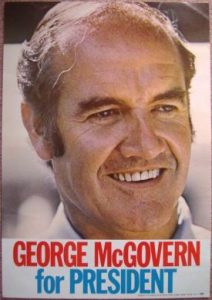
June 2, 1972
I have been sticking my neck out in other directions lately too – have become very involved in George McGovern’s presidential campaign. I have put in some time at the campaign headquarters, and then got nailed to organise the local precinct. It is really rather fun, once I got over the initial panic. Support for him is very strong in this area, so I was lucky in the number of people I could con into working for me. Our house is going to be the headquarters for all 30 Cupertino precincts Tuesday (election day), so that should be interesting too. Am meeting all sorts of interesting people, especially the out-of-state students who are travelling around working for him. There are some neat kids amongst them.
McGovern won the nomination, but lost the November election to incumbent Richard Nixon. Meanwhile, I was feeling ambivalent about my own status. After five years in the US, a Resident Alien may commence the application process to become a citizen. Was I ready to do that? Could I turn my back on the land that had nurtured me and my ancestors? Could I pledge allegiance to a country whose foreign incursions I could not support? On the other hand, how badly did I want to share with my neighbors in making decisions about this place we all now called home? For most immigrants, this is a decision that requires careful thought and soul-searching. In the end, my husband and I decided to apply for citizenship. We didn’t know then how many years, frustrations and phone-calls it would take. But that’s another story.
Women’s rights moves into politics
Continuing my exploration of feminism in the 1970s, a profile for my New Zealand newspaper of a woman political candidate.
Women in Politics Part II
Women’s rights moves into politics
Cupertino, CA, October 1972
Rhoda Freier is a new phenomenon in American politics. She is an avowed feminist who has carried the banner of the women’s movement out of the rap sessions and the action groups, and into the male-dominated arena of party politics. As the Democratic Party candidate for the 22nd California Assembly District, her platform is environmental protection and zero population growth.
Until seven years ago Rhoda Freier’s life reflected the malaise of many an American housewife whose children are gone off to school, leaving her with time on her hands. Then the Freiers moved to California. Suddenly all her latent dissatisfactions burst into full bloom. “California does that to people,” she says. Maybe it’s something in the air!”She went back to college to continue her studies in biology and to upgrade her teaching qualification. Her biology studies led her next to Zero Population Growth. Environmental and population concerns began to coalesce into women’s problems.
National Organization for Women (NOW) was the culmination of all these interests and the one which has commanded her strongest loyalties. She became president of the South San Francisco Bay chapter two years ago. As the mainstream of the women’s movement moved toward politics as the only effective method of achieving equality for women, it pushed her along with it.
Diffident and unwilling at first, she surprised herself by winning the three-way race for the Democratic nomination for 22nd District with a handsome 50 percent of the votes. The general election next month is going to be a more difficult proposition. “No matter how strongly you feel about an issue, you have to know how to go about it, and I really didn’t.” Her neophyte campaign organization functions on “a crisis to crisis basis.” Like most candidates, she directs the emphasis herself, with help from consultants within the Democratic Party. It is a strongly woman-centered effort, drawing heavily from NOW and ZPG. Her financial director is a busy young woman with a pre-school family and a part-time job as a children’s librarian, who has still found time to organize events like the jumbo-sized garage sale which netted a whopping $600 for the campaign coffers.
But by no means is it a female chauvinist affair. Ms Freier’s husband is her campaign manager. Paul Ehrlich, author of The Population Bomb, has taken time to speak on her behalf. Promises of help in the crucial pre-election work have come from prominent and experienced male members of the local Democratic Party.
Lack of funds is a chronic problem. Democrats, lacking the big business resources of the Republican Party, have traditionally relied heavily on union support. This in Ms Freier’s case has been conspicuously lacking, partly through her own inexperience, and partly through union opposition to the women’s Equal Rights Amendment, which she supports.
The attitude of the local press, who consistently refer to her as “the Women’s Lib candidate,” has also been an obstacle. “I have no qualms about being identified as a feminist. But the term ‘lib’ or ‘libber’ is used in a denigrating way that is very damaging and insulting.”
She doesn’t feel that being a woman is all that much of a handicap. But neither is it a conspicuous asset. A survey by the National Women’s Political Caucus showed that, of thirty new women candidates in the June primary election, only twelve are still in the race, and only two of these, including Rhoda Freier, won contested primaries.
“It’s hard to know what the factors were: unwillingness to vote for a woman; inexperience on the part of the woman running; lack of money? We’ll never know. But I’m certainly not doing what I did initially, which was to point out that we haven’t even reached the level of tokenism in the number of women in the legislature. Some people may be concerned about this, but the vast majority clearly aren’t.” Nowadays I tackle the positive aspects of my candidacy rather than the fact that I am a woman. I have tried to promote myself as a candidate who is more knowledgeable than most of the other legislators in environmental matters and in the need for population stabilization.”
But she does feel that her candidacy will have an impact on the image of women. “The fact of a woman coming forward as a women’s candidate opens new avenues of thought to a whole lot of people.”
POSTSCRIPT: Rhoda Freier lost the election to the Republican incumbent Assemblyman Richard Hayden, but went on to help establish a Bay Area chapter of the nonpartisan National Women’s Political Caucus.


